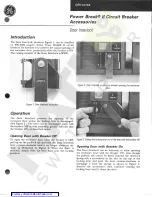
7
3. Cautionary Instructions for Handling MDU Breaker
3.1 Cautionary instructions for using MCCB
●
Electrical work must be performed by a qualified person (electrical worker).
●
Maintenance and inspections must be conducted by someone with specialized knowledge. Turn the host circuit breaker OFF and confirm that no
electricity is flowing. Doing otherwise could cause electrical shock.
●
Connect the line side and load side correctly. When connecting the power supply, make sure that the terminal screws are tightened at the
torque listed on the included terminal screw case. Otherwise, a fire may be resulted.
●
Install MDU Breaker so that no dirt or dust, concrete dust, iron dust, rainwater, or other foreign matter enters. Doing so may result in a fire
or operation accident.
●
Make sure protective grounding is performed for the load device.
●
Be sure to connect the neutral line to the two-phase for a single-phase three-wire system, and connect the neutral line to the neutral-phase
for a three-phase four-wire system.
●
If the product automatically cuts off, resolve the issue before switching the handle to ON. Otherwise, an electric shock or a fire may be resulted.
●
To configure, first set the MDU Breaker main unit to OFF or TRIP.
Caution
3.2 Periodic inspections
●
Make sure that the product is not energized prior to performing periodic
inspections. Otherwise, an electrical shock, a device accident, or a fire
may be resulted.
●
Periodically tighten terminal screws. Otherwise, a fire may be resulted.
Caution
To prevent trouble and to maintain the performance of the breaker, inspect the breaker one month after starting use and periodically thereafter according to
the operation environment.
Yardstick for inspection periodicity
Clean and dry environment
1
2
3
Once every 2 to 3 years
Once a year
Once every six months
Environment not exposed to severe
dust, corrosive gas vapor, salt, etc.
Other places than 1 and 2
Criterion
Inspection item
4. Check whether the temperature has abnormally risen.
Maximum allowable terminal temperature rise is 60K.
(There is a slight temperature difference between the
terminals on the line side and the load side, and between the
middle pole and the left and right pole.)
3. Internal submersion by inundation or substantial mud or dust
not adhered?
5. Is there ON/OFF operation by handle smooth?
6. Is there TRIP operation by trip button?
1. Is any conductor connection not loosened?
2. Are the cover and base not cracked or otherwise damaged?
Is the handle not broken?
By visual inspection, the rear studs of terminals, the tightening area of the main body,
and the molded area must not discolor from burning.
When the current of each phase is balanced, there is no terminal that shows an
abnormally high temperature rise.
When the load current is balanced, the temperature difference between the left and
right of the base is small.
Operation should be done smoothly.
The circuit breaker should be able to reset after tripping.
No loosening allowed. If loosened, the connection should be retightened with
such appropriate torque as indicated in the Attached Table.
No internal submersion nor substantial mud and/or dust adhered to. In case of
internal submersion, replace the circuit breaker with a new one, or have it
overhauled at our service center.
No crack nor damage on the cover and base. No broken handle.
Summary of Contents for NF400-HEW
Page 55: ......
Page 56: ...LN107A329H02 IB63E31 A 1911 MEE MDU Breakers Nov 2019 ...





































